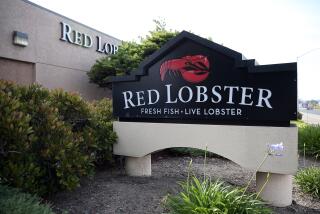âChemistryâ Was Right in Rockefeller Center Talks : Real Estate: Mitsubishi Estate is a stolid and conservative investor. Its commitment to the âquality . . . and values of the Rockefeller familyâ appealed to the sellers of one of New Yorkâs prime properties.
TOKYO â Yataro Iwasaki was a man with an eye for real estate. In 1890, the founder of the Mitsubishi Zaibatsu--a large industrial combine that later spawned a loose family of 41 companies with combined annual revenue approaching $200 billion--bought a tract of swampy land adjacent to the Imperial Palace.
Today, Iwasakiâs little corner of Tokyo is potentially the most valuable turf in the world. It lies beneath the concrete bedrock of the premier business districts of Marunouchi and Otemachi.
Nearly a century after the entrepreneur bought his 87 acres from the central government, most of the land is still in the hands of his corporate heirs and its value has skyrocketed so high during the postwar real estate boom that nobody seems to know exactly how much it is worth. The book value is $5 billion, but analysts say that figure is so low that it is meaningless.
Now the foremost landlord to Japan Inc. is about to become Americaâs most conspicuous property owner.
Mitsubishi Estate Co., formed out of the real estate division of Iwasakiâs Mitsubishi conglomerate in 1937, announced in Tokyo and New York on Monday that it plans to acquire a 51% stake in the Rockefeller Group, the real estate investment arm of the Rockefeller family trusts.
The $846-million investment would give Mitsubishi Estate at least nominal controlling interest in Rockefeller Center, which includes Depression-era Art Deco landmarks in Midtown Manhattan such as Radio City Music Hall and the RCA Building.
Mitsubishiâs financial gambit may stir up unpleasant emotions in those who are concerned about the flood of Japanese and other foreign investments in the United States, but these critics might have a hard time arguing that the Mitsubishi-Rockefeller deal represents any kind of clash of cultural values.
In a curious way, Iwasaki and his Mitsubishi men have a lot in common with John D. Rockefeller, founder of the Standard Oil trust, and the scions of his all-American zaibatsu .
So apparent was this affinity that Raymond F. Pettit, senior vice president and chief financial officer for the Rockefeller Group, told reporters in Tokyo that Mitsubishi was chosen over nine other Japanese and foreign suitors because of a certain âchemistryâ at the negotiating table.
In Mitsubishi Estate, the stewards of the Rockefeller legacy saw the kind of stolid and conservative investor that would make a long-term commitment to âthe quality, the traditions and the values associated with the Rockefeller family,â William G. Bowen, chairman of the Rockefeller Trust Committee, said in a statement.
Iwasaki, like the original Rockefeller, had a relatively humble start--for a samurai. The son of a minor feudal clan on the island of Shikoku, he struck out in business in 1870 with a shipping and mail courier service plying the coastal waters between Tokyo and Osaka. He would later win government concessions for mail routes to the United States and China, and would merge with his bitter rival.
Japan in the late 19th Century had only recently emerged from nearly three centuries of feudal isolation and was engaged in an intense national effort to build military might and catch up with the industrialized West. A handful of capitalists such as Iwasaki played major roles in their countryâs rapid development by taking over state-owned industries and forming huge industrial and financial conglomerates, the zaibatsu .
By 1890, the year Iwasaki made his farsighted real estate purchase in Tokyo, Mitsubishi had diversified into finance, mining, shipbuilding and heavy machinery. The company grew into one of three major zaibatsu, along with Mitsui and Sumitomo, and was tightly held by the Iwasaki clan until the 1920s, when public shares were first issued.
The subsidiary Mitsubishi Heavy Industries would later build the Zero fighter planes that tormented U.S. fleets in the Pacific during World War II and would launch the worldâs largest battleship, the Musashi. Like the rest of corporate Japan, Mitsubishi was an integral part of the war machine.
âWe must perform our duty with a clear-cut resolve to serve, above all things, the interests of the state,â Koyota Iwasaki, a descendant of the founder who became president of the trust company controlling the zaibatsu , told a gathering of top Mitsubishi executives two days after the Dec. 7, 1941, attack on Pearl Harbor.
Where the stories of the Iwasakis and their fellow zaibatsu families differ from those of the Rockefellers or the Carnegies is that it took three or four decades for the concept of anti-monopolistic regulation to reach the Japanese islands, and only then at the insistence of postwar U.S. occupation authorities.
The U.S. Supreme Court broke up Rockefellerâs Standard Oil Co. in 1911. The American-inspired dissolution of the Japanese monopolies after the war was only half completed, however, when they were allowed to reassemble as loosely structured industrial groups, now known as keiretsu .
Mitsubishiâs case is typical of how the zaibatsu have survived. Gone are family control and the trust company that was once at the top of the pyramid. But Mitsubishi Corp., the general trading subsidiary, reassembled itself immediately after the American occupation ended in 1947 and now âcoordinatesâ the activities of the group. The heads of the 41 companies in the group meet monthly to map out strategies in what is euphemistically called a presidentsâ club.
Mitsubishi Heavy Industries also reunited after a breakup to reestablish itself as Japanâs leading defense contractor. Most notably, it is the company that will take the lead in developing the fighter jet of the next generation, the FSX, subject of much controversy earlier this year. American critics nearly scuttled a U.S.-Japan development program, warning that Mitsubishi Heavy would use U.S. military technology to gain international dominance in the commercial aerospace industry (a charge that Mitsubishi denied).
Mitsubishi Estate, like the other companies in the group, is operated independently yet remains 20.9% owned by Mitsubishi Group affiliates--demonstrating the classic pattern of cross-shareholdings and interlocking directorates that U.S. officials say can generate the kind of clannish business relationships that become âstructural impedimentsâ to free trade.
Mitsubishi companies have not been singled out in ongoing trade negotiations, but serious question might be raised as to whether an American company could ever make an investment in Japan comparable to Mitsubishi Estateâs proposed stake in the Rockefeller Group. As such, the deal is likely to match Sony Corp.âs $3.4-billion bid for Columbia Pictures as a symbol of imbalance in economic relations between the two nations.
The Rockefeller venture will not be Mitsubishi Estateâs first move into the U.S. market, but it is its most obvious. The company developed a 102-acre residential tract in Jupiter, Fla., 16 years ago, but now refuses to disclose financial details. It joined partnerships constructing an office building in Portland, Ore., in the early 1980s, and is involved in a 1,000-acre resort project in Palm Desert.
The companyâs only major undertaking to date has been its investment, with two other partners, in the 777 Tower building at Citicorp Plaza in Los Angeles, a $500-million project that will have 3 million square feet.
Back home, Mitsubishi Estate has a reputation among industry analysts as a conservative and cumbersome giant that has missed many opportunities in overseas real estate while its rivals were acting more quickly.
The security represented by the companyâs holdings in the Marunouchi and Otemachi districts, where it owns 32 major buildings and still has title to about 50 acres, perhaps accounts for the complacency. Add 39 office buildings in other parts of Tokyo and elsewhere in Japan, for a total of 25 million square feet of office space, and Mitsubishi stands out as Japanâs largest commercial landlord.
Indeed, rental income makes it by far the countryâs most profitable real estate concern. It takes in about $269 million a year in after-tax profit on more than $2 billion in gross revenue.
The company is also beginning to assert itself with high-profile development projects, such as the 75-story Landmark Tower it plans to start building soon at the Minato Mirai complex in Yokohama. It will be Japanâs tallest building.
Yet real estate analysts say the company faces some tough bureaucratic wrangling before it can capitalize on its so-called latent assets in the Marunouchi and Otemachi business districts. Mitsubishi has been unable to persuade Tokyo metropolitan authorities to revise density limits for the area, so the eight- to 10-story office blocks now lining the streets may represent the maximum development for the foreseeable future.
The core of the city, meanwhile, may move west to the urban hub of Shinjuku, where a cluster of skyscrapers stands and city authorities envision erecting a new financial district on landfill islands in Tokyo Bay.
Yet Iwasakiâs 99-year-old investment in Tokyo real estate is hardly losing value. Results of recent surveys suggest that the cost of commercial land is leveling off, but not even the most pessimistic analyst predicts a crash. At last reckoning earlier this year, the National Land Agency calculated the market price of land in the Marunouchi district as holding firm at more than $22,000 a square foot, a rate that might make the Empire State Building seem cheap--if it were for sale.
WHAT MITSUBISHI BOUGHT
Through its acquisition of 51% of Rockefeller Group stock, Mitsubishi Estate Co. will assume a 14.5% controlling interest in New York Cityâs Rockefeller Center. Most of the buildings within the 22-acre complex are involved in the deal.
1--Manufacturers Hanover
2--Ine Rockefeller Plaza
3--10 Rockefeller Plaza
4--Simon & Schuster Building
5--LaMaison Francaise
6--30 Rockefeller Plaza
7--1250 Avenue of the Americas
8--British Empire Building
9--Palazzo dâItalia
10--Radio City Music Hall
11--1270 Avenue of the Americas
12--International Building
13--International Building North
14--The Associated Press Building
15--Warner Communications Building
Source: Rockefeller Group
More to Read
Inside the business of entertainment
The Wide Shot brings you news, analysis and insights on everything from streaming wars to production â and what it all means for the future.
You may occasionally receive promotional content from the Los Angeles Times.










